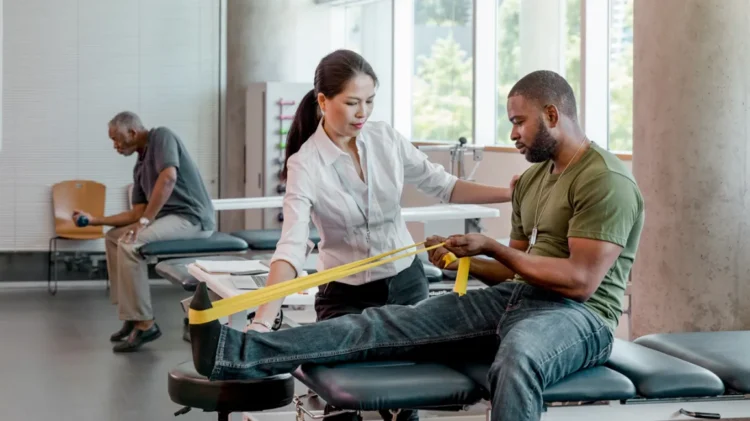Seeing a physical therapist might be intimidating for some people because they are unsure of what to anticipate. Physical therapists are skilled specialists who can help with pain management, so there’s no need to be concerned. You might be able to ultimately get rid of your pain with their help. If you have a physical therapy appointment coming up soon, it’s critical that you arrive fully prepared. Here are a few things every first-time patient should know to avoid any confusion or worry during their session.
Page Contents
1. Be Ready For The Questions

Source: medicalnewstoday.com
You should expect to spend 45 minutes to an hour with the therapist after the one-on-one portion of the consultation begins. The session will include both the assessment and the treatment.
The therapist will ask you a series of questions about your discomfort and why you’re seeking treatment in the first phase of the evaluation. You must offer information on the following topics:
- When did your symptoms begin, and what could have triggered them?
- What factors make your symptoms worse or better?
- What other treatments have you tried for this?
The physical therapist will use your answers to other questions to guide the rest of the assessment.
The therapist will also inquire about your physical therapy goals. This way, you and the physical therapist will both know what to expect at your initial physical therapy appointment and after that. This is important to ensure that you and your partner are on the same page about what you want to get out of these sessions.
Click here to know more about physical therapy.
2. Clothes To Wear
When making your appointment, inquire as to whether you should wear or bring a specific sort of attire to your initial visit. It’s critical that you feel relaxed. Dress as though you’re going to the gym, as your session may include stretches and light activity.
Keep in mind that you may need to lie down or get into awkward postures, so dress comfortably. Shoulder-tank tops or loose T-shirts will allow the therapist to examine you more comfortably.
Wear shorts or loose slacks that can be pulled up over the knee if you have a leg or knee injury.
3. The Relationship Between You And Your PT
Your connection with your physical therapist should seem like a partnership in which both of you are working to improve how you feel and move. Feel free to ask any questions you may have concerning what is happening during your therapy. Your physical therapist should encourage you to ask questions and should be able to answer them clearly and concisely about your treatments, condition, and rehab program.
If you have a disease, injury, or surgical procedure that affects your functional mobility, your physical therapist is one of the finest people to talk to. However, you will only get what you put into physical therapy.
4. Do Physical Therapy Hurt?

Source: healthline.com
The goal of your physical therapist is to help you attain optimum functionality while reducing pain. You may suffer some pain or discomfort during your therapy, depending on the severity of your ailment or damage, particularly after surgery. Always let your physical therapist know whether and how much pain you’re in so they can continue to make modifications to help you progress with the least amount of discomfort possible.
5. Develop An Assessment
Your physical therapist will share the findings with you after they have a clear picture of the cause or causes of your major complaint. They’ll go over any imbalances that are causing your symptoms with you and offer the remedy or therapies that will be most beneficial to you.
Ask for clarification if necessary. If something doesn’t make sense, tell your therapist, and follow up with any next steps or questions you have about moving forward.
6. Treatment Plan
Your physical therapist will create a treatment plan for you that is tailored to your specific needs, and you will discuss the goals and outcomes with them.
After the initial evaluation, your physical therapist can begin therapy right away, using therapeutic techniques such as electrical stimulation—this aids in the management of pain and the improvement of muscle function. Your physical therapist will also recommend particular exercises for you to undertake at home.
When you have open communication with your physical therapist, you will have a suitable treatment plan. Tell your doctor how you’re feeling, what’s working and what isn’t so you can get better results.
7. Duration Of Treatment

Source: thedacare.org
Expect to spend around an hour on your first visit getting to know your therapist and completing the initial evaluation. Your physical therapist will explain how often and for how long they recommend you undergo therapy. However, most sessions last 45 minutes to an hour.
Your physical therapist may give you some home exercises to help you progress between appointments, depending on your condition or injury.
8. Insurance And Physical Therapy
On the off chance that you have health care coverage, contact your supplier or the staff from the facility, and instruct yourself about your advantages and non-intrusive treatment inclusion.
Regardless of whether you require Physical Therapy for muscular, vestibular, or neurological conditions, most health care coverage providers repay all or a piece of the charges. Continuously have clear data about your health care coverage inclusion. Contact the workplace supervisor at your ideal facility on the off chance that you have inquiries concerning benefits.
9. Review Your Plan
You and your physical therapist will devise a plan of action now that you have a better understanding of the reasons for your problems and the treatments that can help cure them.
You can also discuss various recommendations and decide on the number of follow-up appointments that would work best for your budget, schedule, and treatment plan. Your therapist can prescribe some exercises for you to do at home to address any imbalances discovered during the evaluation.
Prepare to do the following to make the most of your time:
- Recognize your participation in the rehabilitation process as well as your long-term functioning objectives.
- Perform a few moves or exercises.
- Bring your calendar so you’ll know when you can schedule your next appointment.
Conclusion
Now that you understand the steps you must follow during your physical therapy sessions, schedule an appointment with your doctor today and get going on the path of recovery.





